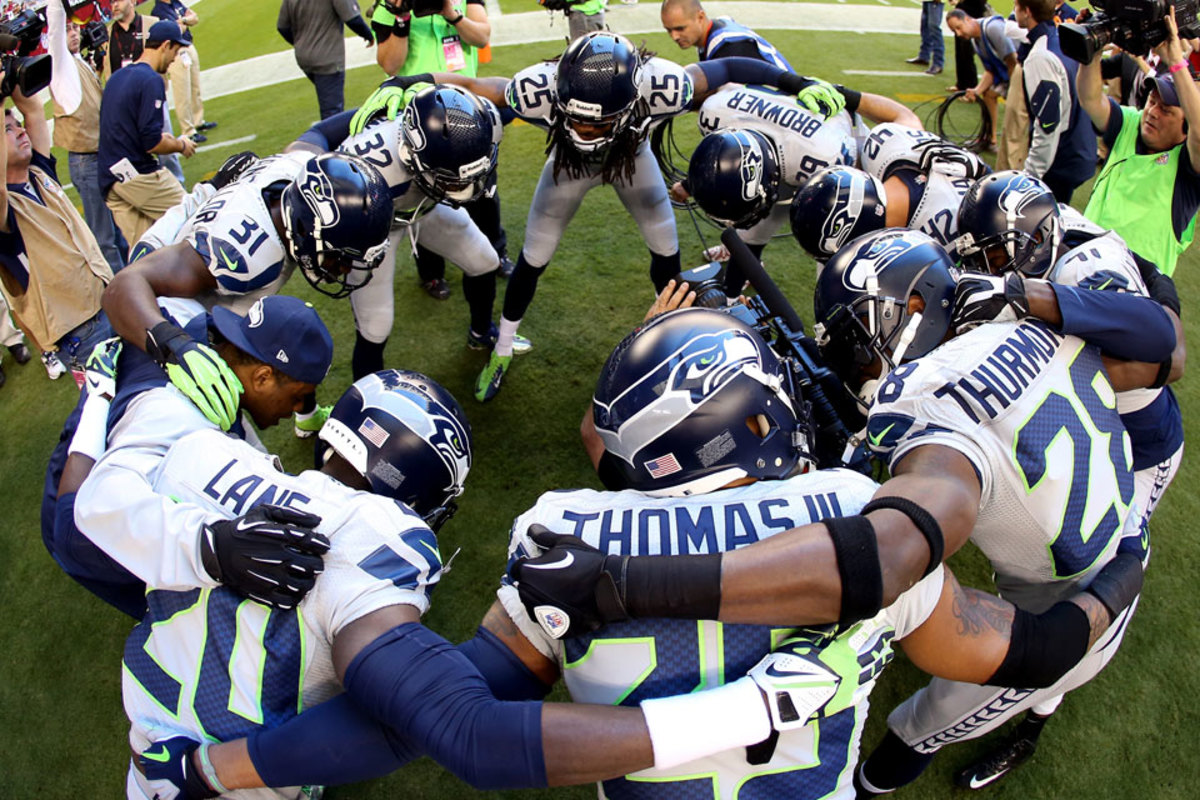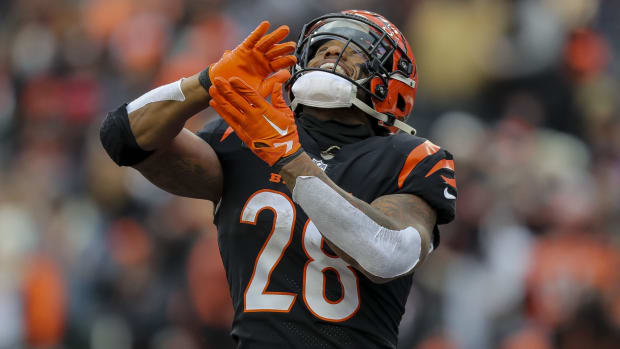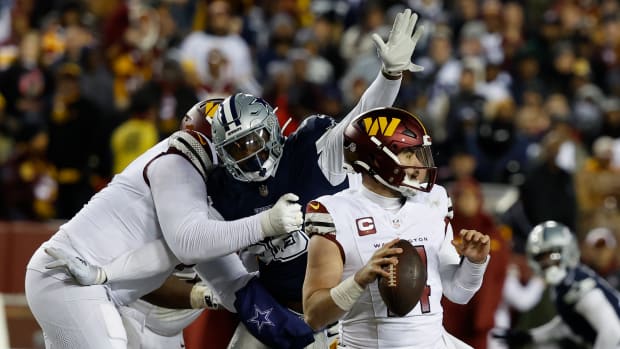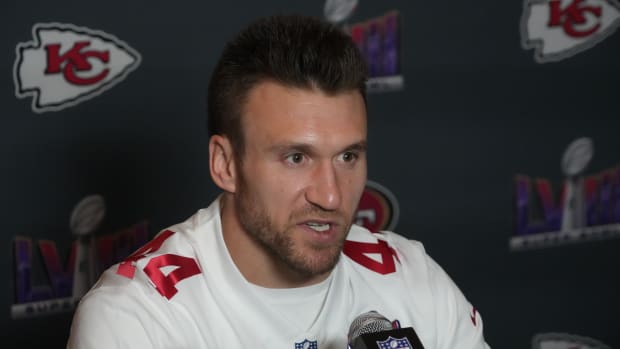On Film Study, Texting Coaches and Seattle’s MVP
My first visit to NFL Films came in October 2008. As a senior in college I sent Ron Jaworski an NFL book I’d written, and he invited me to his office to sit in on some tape study. Coincidentally, that same week I also had an invitation to sit in the broadcast booth of a Monday Night Football game. It was midterms at College of Idaho, but seeing two NFL dreams positioned to come true, I booked a cross-country flight and told professors I’d need to take my exam either early or late.
The MNF experience was every bit as sensational as one would guess; it was my first in-person NFL experience to boot. But the more important experience, by far, was visiting Jaworski’s office at NFL Films.
The office is in the first room on the right atop the staircase that winds up from the main lobby. Jaws greeted me at the door and invited me to join the group, which consisted of a trio of NFL Matchup Show interns, along with his Matchup producer, Greg Cosell. It was immediately apparent that I was the least knowledgeable football person there. The interns, all around my age, were former college players. And Cosell had been studying the game with former NFL players for the better part of 20 years. I’d been “studying” football by myself on TV copy for 10 years.
The making of the 2015 NFL scheduleInside Lawrence Tynes’ MRSA nightmareJoe Linta is no ordinary agentThe Tim Tebow TrialRex Ryan’s fresh start in BuffaloAntonio Gates moonlights as a boxing promoter
Fortunately I was wise enough to not speak. Better to let everyone think you’re the dumbest person in the room than to open your mouth and prove them right. In the first 15 minutes, my only utterance was, “I used to, but then my connection got a new job and my pipeline was cut off.” This was in response to Jaws asking me if I had access to the type of “All-22” coaches film the group was studying.
Knowing what I know now, I could have expanded my answer to include a mention of how even when I had coaches film, I didn’t know what I was watching. I’d always fancied myself a “football guy.” But the coaches film presented a whole new world. With all 22 players in the shot, and the camera at an angle that revealed every intricacy of the players’ movement, it looked like a different sport. Being able to see the safeties meant having the first clue towards solving the puzzle of the defensive scheme. And your knowledge of the defensive scheme often goes only as far as your knowledge of the offensive scheme. Which for me, meant “next to nowhere.”
Dread washed over me as each passing moment seemed to obliterate more and more of the typical analytical angles I’d spent my writing career exploiting. Something like a player’s “It” factor was suddenly exposed as complete nothingness. Same for “moxie,” “wanting it” and, the room’s favorite phrase to disparage, “being a winner.”
“Clearly Philip Rivers did not practice being a winner this offseason,” Cosell announced to chortles as we watched film of a struggling Chargers team. I laughed along.
Charley Casserly, who had recently been the first GM of the Houston Texans, also was in the room, doing his own film study in the back corner. And a little before lunchtime, Matt Millen, who had just been fired in Detroit during the first 0-16 season in NFL history, showed up.
Millen couldn’t have been a nicer guy. Most striking was that if there was an alpha dog in that film room, he was it. He knew everything about what we were watching. He saw things nobody else saw. It took him only a few plays to recognize schematic patterns. And, most importantly, he had a large capacity for explaining it all.
This is how I learned that there are no idiots in professional football. Because, obviously, a young pontificator like me at the time would have been prone to branding an unsuccessful GM like Millen as such. But Millen was the smartest football mind I’d ever encountered; it’s too bad he went into a front office instead of coaching. He would have been one of the best linebackers coaches in the league, and who knows what would have happened from there.
I’ve kept in touch with Millen over the years, and I see Jaws about once a year. I’ve also become good friends with a few of those interns, most notably Sean Coffey, a former wideout at Missouri and razor-sharp football mind who has since gone on to be an analyst and producer for NFL Network. But of all the people I met that first day, Cosell is the one with whom I’m most connected. Having never played football himself but possessing an unparalleled passion and analytical brain for it, he’s taught me the most about the game.
I’ve made multiple trips to NFL Films each year to watch with tape Cosell, the latest being this past weekend. He and I spent two days studying some of the more intricate defenses around the league (Philly, Arizona, etc.), as well as some of the league’s most unique running games (Dallas, Philly, San Francisco, Seattle). I've watched hundreds and hundreds of hours of coaches film each year since it became available on Game Rewind in 2012, and having spent several hours a year with NFL coaches, I still came away from this past weekend with more than 20 pages of notes on new items learned or concepts to further evaluate. The study of coaches film is a never-ending learning process.
I’ll spare you the minutiae of what I learned. (Or, actually, I’ll sprinkle it throughout my pieces for The MMQB this upcoming season.) But the highlight: Cosell and I got into a deep philosophical discussion on who is the most valuable player on Seattle’s defense. It’s a fascinating question because five guys—Richard Sherman, Earl Thomas, Kam Chancellor, Bobby Wagner and, as a nickel defensive tackle, Michael Bennett—are easily among the top three players leaguewide at their respective positions. With all of these guys cast together in a fairly straightforward scheme, whom you find most valuable essentially speaks to your belief in what position is most valuable and why.
Millen was the smartest football mind I’d ever encountered. Too bad he went into a front office instead of coaching.
Unable to reach a definitive conclusion, I suggested we text former Seahawks coordinator Dan Quinn with the question. He’s now the head coach in Atlanta and, when I met him two years ago, he was very honest and open with me. Plus Cosell and I each had a quick, pleasant encounter with him at the combine this past February.
I fired off a carefully worded text to Quinn and felt the way I used to feel when texting girls I liked. “We’ll see if he texts back,” I said, hedging against my disappointment in the event he didn’t. Cosell joined in the hedging, listing all the perfectly good reasons why Quinn might not text back. (It’s Sunday. It’s draft time. He may not want to answer that question, even off the record. You never know what’s going on with a guy.)
About 20 minutes later, my phone dinged. Cosell stopped the film mid-play (which never happens), and we exchanged the type of eager eye contact generally reserved for life-changing good news. Indeed, Quinn had responded—at length. We were off the record, so I won’t share the details, but his message was made clear in his first sentence: Choosing one player from that defense is like choosing your favorite kid.
It was great to know that someone much more knowledgeable than us had similar troubles identifying the Seahawks’ best player. For the next several hours, Cosell and I continued to watch film, but found ourselves rehashing the text exchange and discussion every 20 or 30 minutes. We were two adults turned giddy young boys, studying a very complex game orchestrated by very intelligent men.
Nickel Package
Draft QBs, Now & Then
In his weekly draft column, Robert Klemko has an NFL scout share his team's draft grades on Jameis, Mariota and the 12 first-round quarterbacks taken since 2011, from Luck to Ponder. FULL STORY
1. About Jameis Winston not attending the draft... What’s more likely: that Winston would give up a dream-come-true trip in order to watch at home (albeit with his grandmother, who can’t readily travel); or that when Winston visited Roger Goodell at the league office a few weeks ago, he was told—perhaps subtly but probably not so subtly—to stay away. The NFL is coming off a nightmarish season in regards to star players and domestic violence. What could be worse than having the No. 1 pick in the draft on stage bro-hugging the commissioner while a civil lawsuit for rape hangs over him?
2. There’s no chance Tim Tebow makes the Eagles roster. Besides being a horrendously inconsistent passer, Tebow’s not a quick, explosive runner who can make a run-based system—even one like Chip Kelly’s—more dynamic. And something nobody’s talked about with Tebow: his football IQ is low. Excruciatingly low. Offenses have always had to be simplified for him, even dating back to his Florida days. Kelly’s system is actually one of the simplest in the league (this fact gets obscured because the offense operates at such a fast tempo), but even it isn't simple enough.
3. In closely examining Dallas’s and Philadelphia’s running games this past weekend, I gained a new appreciation for the LeSean McCoy trade. Great as McCoy is, there were a lot of times he left yards on the field by dancing instead of hitting the point of attack. Kelly’s scheme is designed for a downhill runner. DeMarco Murray, who can’t wiggle but can finish on contact, is well-suited for this. With Ryan Mathews also in Philly, Murray won’t put up numbers as big as McCoy did. But Murray is the better fit for Kelly’s ground game.
4. Nice try, Bob. Robert Griffin reportedly reached out to Tom Brady, wanting to pick the future Hall of Famer’s brain. Brady’s response: “Not until my career is done, Rob.” Perfect.
5. Lost in the glare from the spotlight cast on Troy Polamalu’s retirement is the retirement of Ike Taylor. The Steelers cornerback entered the league in 2003 (same as Polamalu) as a fourth-round pick. In typical Steelers fashion, he learned from the sideline his first two seasons and then went on to be a 10-year starter. A respected team-first guy, the long-armed Taylor was also one of the league’s best cover artists for many of those 10 years. He often shadowed the opposing No. 1 receiver. If not for hands that Taylor himself once told me “are damn near like feet,” he would have had multiple interceptions each season and been a perennial Pro Bowler.
Follow The MMQB on Facebook, Twitter and Instagram.
[widget widget_name="SI Newsletter Widget”]














































